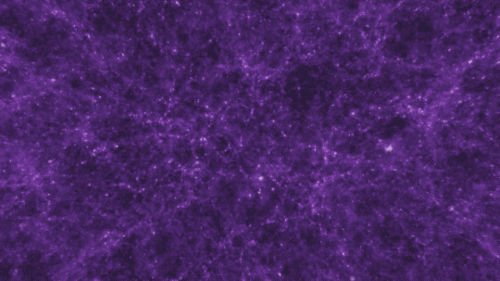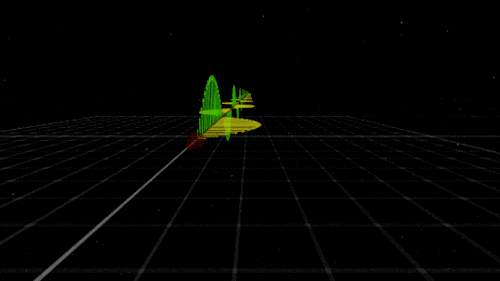Dive into a world of creativity!
Particle Physics - Blog Posts
physics girlboss moment of the day scheduled an interview at the country's largest accelerator nothing can stop me now
May the Four Forces Be With You!
May the force be with you? Much to learn you still have, padawan. In our universe it would be more appropriate to say, “May the four forces be with you.”

There are four fundamental forces that bind our universe and its building blocks together. Two of them are easy to spot — gravity keeps your feet on the ground while electromagnetism keeps your devices running. The other two are a little harder to see directly in everyday life, but without them, our universe would look a lot different!
Let’s explore these forces in a little more detail.
Gravity: Bringing the universe together

If you jump up, gravity brings you back down to Earth. It also keeps the solar system together … and our galaxy, and our local group of galaxies and our supercluster of galaxies.
Gravity pulls everything together. Everything, from the bright centers of the universe to the planets farthest from them. In fact, you (yes, you!) even exert a gravitational force on a galaxy far, far away. A tiny gravitational force, but a force nonetheless.

Credit: NASA and the Advanced Visualization Laboratory at the National Center for Supercomputing and B. O'Shea, M. Norman
Despite its well-known reputation, gravity is actually the weakest of the four forces. Its strength increases with the mass of the two objects involved. And its range is infinite, but the strength drops off as the square of the distance. If you and a friend measured your gravitational tug on each other and then doubled the distance between you, your new gravitational attraction would just be a quarter of what it was. So, you have to be really close together, or really big, or both, to exert a lot of gravity.
Even so, because its range is infinite, gravity is responsible for the formation of the largest structures in our universe! Planetary systems, galaxies and clusters of galaxies all formed because gravity brought them together.
Gravity truly surrounds us and binds us together.
Electromagnetism: Lighting the way

You know that shock you get on a dry day after shuffling across the carpet? The electricity that powers your television? The light that illuminates your room on a dark night? Those are all the work of electromagnetism. As the name implies, electromagnetism is the force that includes both electricity and magnetism.
Electromagnetism keeps electrons orbiting the nucleus at the center of atoms and allows chemical compounds to form (you know, the stuff that makes up us and everything around us). Electromagnetic waves are also known as light. Once started, an electromagnetic wave will travel at the speed of light until it interacts with something (like your eye) — so it will be there to light up the dark places.

Like gravity, electromagnetism works at infinite distances. And, also like gravity, the electromagnetic force between two objects falls as the square of their distance. However, unlike gravity, electromagnetism doesn't just attract. Whether it attracts or repels depends on the electric charge of the objects involved. Two negative charges or two positive charges repel each other; one of each, and they attract each other. Plus. Minus. A balance.
This is what happens with common household magnets. If you hold them with the same “poles” together, they resist each other. On the other hand, if you hold a magnet with opposite poles together — snap! — they’ll attract each other.
Electromagnetism might just explain the relationship between a certain scruffy-looking nerf-herder and a princess.
Strong Force: Building the building blocks

Credit: Lawrence Livermore National Laboratory
The strong force is where things get really small. So small, that you can’t see it at work directly. But don’t let your eyes deceive you. Despite acting only on short distances, the strong force holds together the building blocks of the atoms, which are, in turn, the building blocks of everything we see around us.
Like gravity, the strong force always attracts, but that’s really where their similarities end. As the name implies, the force is strong with the strong force. It is the strongest of the four forces. It brings together protons and neutrons to form the nucleus of atoms — it has to be stronger than electromagnetism to do it, since all those protons are positively charged. But not only that, the strong force holds together the quarks — even tinier particles — to form those very protons and neutrons.
However, the strong force only works on very, very, very small distances. How small? About the scale of a medium-sized atom’s nucleus. For those of you who like the numbers, that’s about 10-15 meters, or 0.000000000000001 meters. That’s about a hundred billion times smaller than the width of a human hair! Whew.
Its tiny scale is why you don’t directly see the strong force in your day-to-day life. Judge a force by its physical size, do you?
Weak Force: Keeping us in sunshine

If you thought it was hard to see the strong force, the weak force works on even smaller scales — 1,000 times smaller. But it, too, is extremely important for life as we know it. In fact, the weak force plays a key role in keeping our Sun shining.
But what does the weak force do? Well … that requires getting a little into the weeds of particle physics. Here goes nothing! We mentioned quarks earlier — these are tiny particles that, among other things, make up protons and neutrons. There are six types of quarks, but the two that make up protons and neutrons are called up and down quarks. The weak force changes one quark type into another. This causes neutrons to decay into protons (or the other way around) while releasing electrons and ghostly particles called neutrinos.
So for example, the weak force can turn a down quark in a neutron into an up quark, which will turn that neutron into a proton. If that neutron is in an atom’s nucleus, the electric charge of the nucleus changes. That tiny change turns the atom into a different element! Such reactions are happening all the time in our Sun, giving it the energy to shine.
The weak force might just help to keep you in the (sun)light.

All four of these forces run strong in the universe. They flow between all things and keep our universe in balance. Without them, we’d be doomed. But these forces will be with you. Always.
You can learn more about gravity from NASA’s Space Place and follow NASAUniverse on Twitter or Facebook to learn about some of the cool cosmic objects we study with light.
Make sure to follow us on Tumblr for your regular dose of space: http://nasa.tumblr.com
Heck yeah weasels.

the one thing thing funnier than this caption is that the only reason they stopped doing it was that the ferret shit in the tube
Neutrinos Hint of Matter-Antimatter Rift

the same underground observatory in Japan where, 18 years ago, neutrinos were first seen oscillating from one “flavor” to another — a landmark discovery that earned two physicists the 2015 Nobel Prize — a tiny anomaly has begun to surface in the neutrinos’ oscillations that could herald an answer to one of the biggest mysteries in physics: why matter dominates over antimatter in the universe.
The anomaly, detected by the T2K experiment, is not yet pronounced enough to be sure of, but it and the findings of two related experiments “are all pointing in the same direction,” said Hirohisa Tanaka of the University of Toronto, a member of the T2K team who presented the result to a packed audience in London earlier this month.
“A full proof will take more time,” said Werner Rodejohann, a neutrino specialist at the Max Planck Institute for Nuclear Physics in Heidelberg who was not involved in the experiments, “but my and many others’ feeling is that there is something real here.”
The long-standing puzzle to be solved is why we and everything we see is matter-made. More to the point, why does anything — matter or antimatter — exist at all? The reigning laws of particle physics, known as the Standard Model, treat matter and antimatter nearly equivalently, respecting (with one known exception) so-called charge-parity, or “CP,” symmetry: For every particle decay that produces, say, a negatively charged electron, the mirror-image decay yielding a positively charged antielectron occurs at the same rate. But this cannot be the whole story. If equal amounts of matter and antimatter were produced during the Big Bang, equal amounts should have existed shortly thereafter. And since matter and antimatter annihilate upon contact, such a situation would have led to the wholesale destruction of both, resulting in an empty cosmos.
Somehow, significantly more matter than antimatter must have been created, such that a matter surplus survived the annihilation and now holds sway. The question is, what CP-violating process beyond the Standard Model favored the production of matter over antimatter?
Many physicists suspect that the answer lies with neutrinos — ultra-elusive, omnipresent particles that pass unfelt through your body by the trillions each second.
To that end, starting in 2010, scientists with the T2K experiment generated beams of neutrinos or antineutrinos in Tokai, Japan, and aimed them toward the Super-Kamiokande neutrino observatory, a sensor-lined tank of 50,000 tons of pure water located nearly 200 miles away in Kamioka. Occasionally, these ghostly particles interacted with atoms inside the water tank, generating detectable flashes of radiation. Detecting a difference in the behavior of the neutrinos and antineutrinos would provide an important clue about the preponderance of matter over antimatter, perhaps opening up a route beyond the Standard Model to a more complete theory of nature. Already, the strange properties of neutrinos provide a possible outline of that fuller story.

Kamioka Observatory, ICRR (Institute for Cosmic Ray Research), The University of Tokyo At the Super-Kamiokande observatory in Kamioka, Japan — shown here when it was being filled with water in 2006 — neutrinos interact with atoms inside the water, generating flashes of radiation that are picked up by the surrounding sensors.
Primordial Neutrinos
The 1998 discovery that neutrinos switch flavors on the fly “may change our most fundamental theories,” President Bill Clinton said at the time, “from the nature of the smallest subatomic particles to how the universe itself works.”
Neutrino oscillations defied the Standard Model’s prediction that the particles are massless, like photons. In order for neutrinos to oscillate, each of their three possible flavors (electron, muon and tau) must be a quantum-mechanical mixture, or “superposition,” of three possible masses. Quantum superpositions evolve over time. So a neutrino might start out with its three mass components giving it pure muon flavor, but as the components evolve at different rates, electron flavor gradually enters the mixture, and the neutrino will have some probability of being measured as an electron neutrino.
There’s no mechanism within the Standard Model by which neutrinos might acquire their tiny, nonzero masses. Also unknown is why all neutrinos are observed to be “left-handed,” spinning clockwise with respect to their direction of motion, while all antineutrinos are right-handed, spinning counterclockwise.
Experts overwhelmingly favor a double-duty explanation of neutrino mass and single-handedness called the “seesaw mechanism,” whereby the known, lightweight, left-handed neutrinos have much heavier right-handed counterparts, and the known antineutrinos likewise have superheavy left-handed counterparts (the light and heavy masses are inversely related, like two sides of a seesaw). For this seesaw explanation to work, the neutrinos and antineutrinos on each side of the seesaw must actually be the same particle, except for their opposite handedness. Numerous experiments are now hunting for an extremely rare radioactive decay that would confirm this “Majorana” nature of neutrinos, thereby shoring up the logic of the seesaw mechanism.
If the theory is correct, then the heavy neutrinos and antineutrinos would have populated the hot young universe, when there was enough energy to beget beastly particles. They would have since decayed. Physicists wonder: Might their decays have produced the matter-antimatter asymmetry? This is the question to which an answer may be emerging — and much sooner than expected.
Tilted Seesaw
There’s good reason to think that neutrinos violate CP symmetry. The one established instance of CP violation in the laws of physics arises among the quarks — the building blocks of protons and neutrons — whose flavor mixing is described by a mathematical matrix similar to the one for neutrino mixing. In the quark case, though, the value of a numerical factor in the matrix that creates a disparity between quarks and antiquarks is very small. Quarks and antiquarks behave far too symmetrically to account for the universe’s matter-antimatter imbalance.

Lucy Reading-Ikkanda for Quanta Magazine
But the neutrino mixing matrix comes equipped with its own factor by which neutrinos and antineutrinos can violate CP symmetry. (Paradoxically, they can behave differently from one another even if they are Majorana particles, identical except for their opposite handedness.) If the lightweight neutrinos and antineutrinos violate CP symmetry, then the hypothetical heavy primordial neutrinos and antineutrinos must as well, and their asymmetric decays could easily have produced the universe’s glut of matter. Discovering CP violation among the lightweight neutrinos “will boost that general framework,” said Neal Weiner, a theoretical physicist at New York University.
The question is, how large will the CP-violation factor be? “The fear was that it would be small,” said Patricia Vahle, a physicist at the College of William & Mary — so small that the current generation of experiments wouldn’t detect any difference between neutrinos’ and antineutrinos’ behavior. “But it is starting to look like maybe we will be lucky,” she said.
To search for CP violation, the T2K scientists looked for evidence that neutrinos and antineutrinos oscillated between muon and electron flavors with unequal probabilities as they traveled between Tokai and Kamioka. The amount of CP violation once again works like a seesaw, with the rate of muon-to-electron neutrino conversions on one side, and corresponding antineutrino conversions on the other. The larger the value of the factor in the matrix, the greater the seesaw’s tilt.
If the seesaw is balanced, signifying perfect CP symmetry, then (accounting for differences in the production and detection rates of neutrinos and antineutrinos) the T2K scientists would have expected to detect roughly 23 electron neutrino candidates and seven electron antineutrino candidates in Kamioka, Tanaka said. Meanwhile, if CP symmetry is “maximally” violated — the seesaw tilted fully toward more neutrino oscillations and fewer antineutrino oscillations — then 27 electron neutrinos and six electron antineutrinos should have been detected. The actual numbers were even more skewed. “What we observed are 32 electron neutrino candidates and four electron antineutrino candidates,” Tanaka said.
With so few total events, it’s too soon to know whether the apparent tilt of the seesaw, signifying a large amount of CP violation, is real or a statistical aberration. Two other new hints of CP violation, however, strengthen the case. First, the newly running NOvA experiment, which generates a beam of muon neutrinos in Illinois and measures electron neutrinos in Minnesota, found a large number of these oscillations, again suggesting that the seesaw may be tilted in favor of neutrino oscillations and away from antineutrino oscillations. Second, researchers at the Super-Kamiokande observatory detected a similar enhancement of electron neutrinos coming from Earth’s atmosphere. (T2K and NOvA both plan to submit their findings for publication later this year.)
Vahle, who presented NOvA’s new results this month in London, urged caution; even when the T2K and NOvA results are combined, their statistical significance remains at a low level known as “2 sigma,” where there’s still a 5 percent chance the apparent deviation from CP symmetry is a random fluke. The results “do give me hope that finding CP violation in neutrino oscillations won’t be as hard as many feared it would be,” she said, “but we aren’t there yet.”
If CP violation among neutrinos is real and as large as it currently seems, then the evidence will slowly strengthen in the coming years. T2K’s signal could reach 3-sigma significance by the mid-2020s. “It’s a very exciting time as we look forward to a lot more data from both experiments,” said Peter Shanahan, a NOvA co-spokesperson.
It isn’t yet known exactly how CP violation in the light neutrino oscillations would translate into CP-violating decays of the heavy set. But discovering the former would point physicists in the latter’s general direction. “If we are starting to see [CP violation] in the neutrino sector, it is certainly a critical result,” Weiner said.
Story from Quanta Magazine
Visit Nanotechnology World Association for more articles